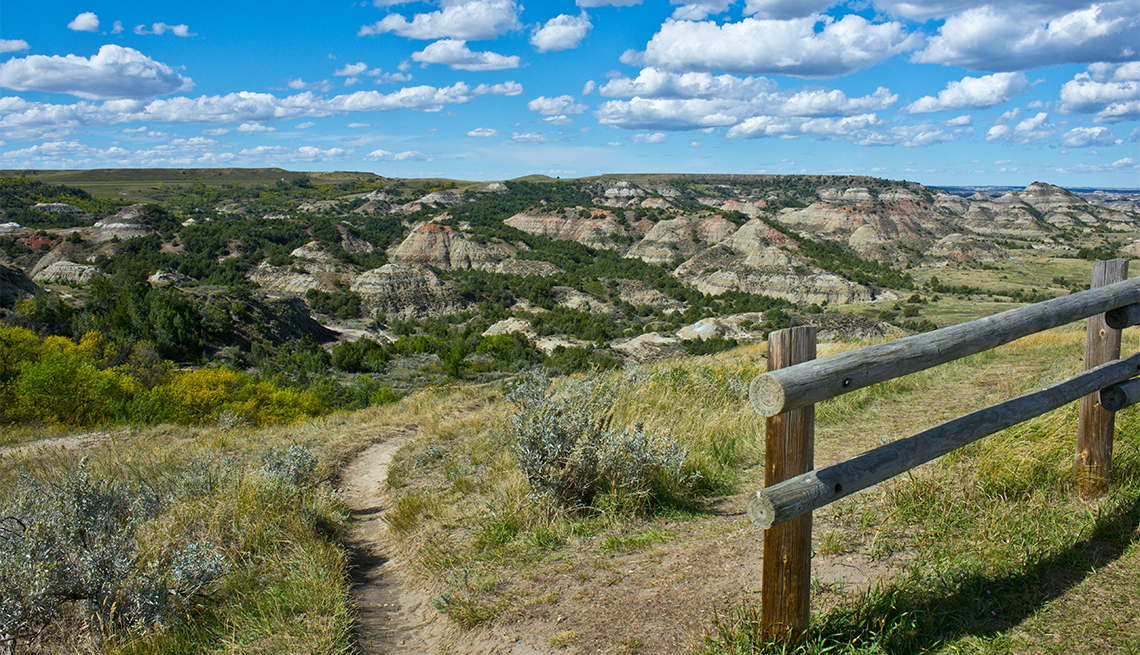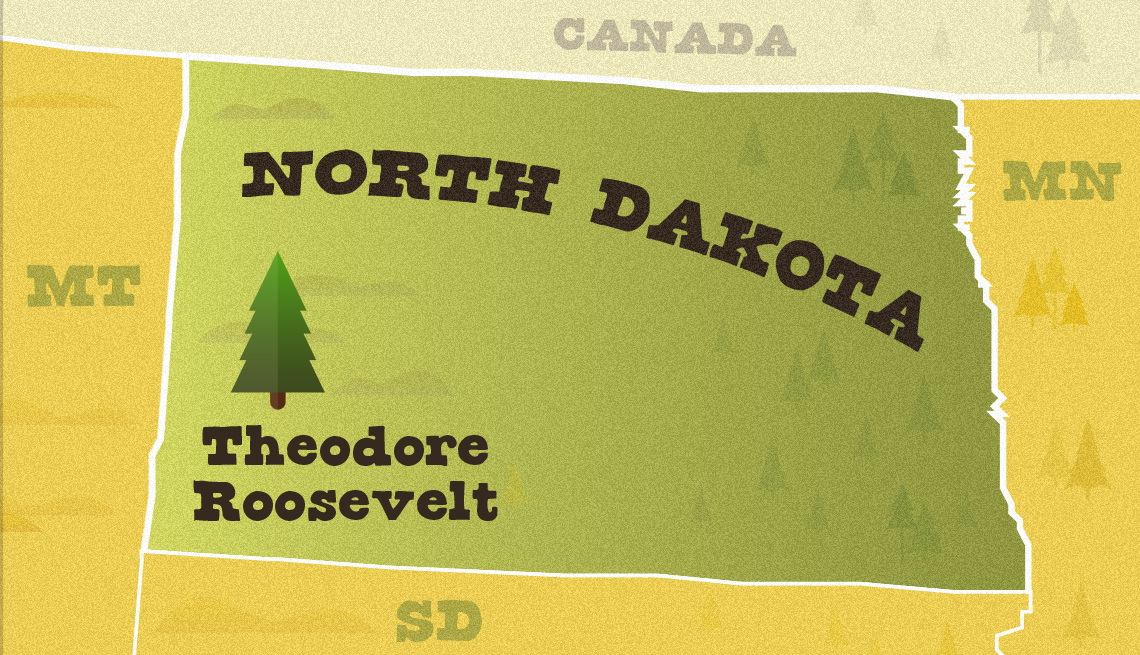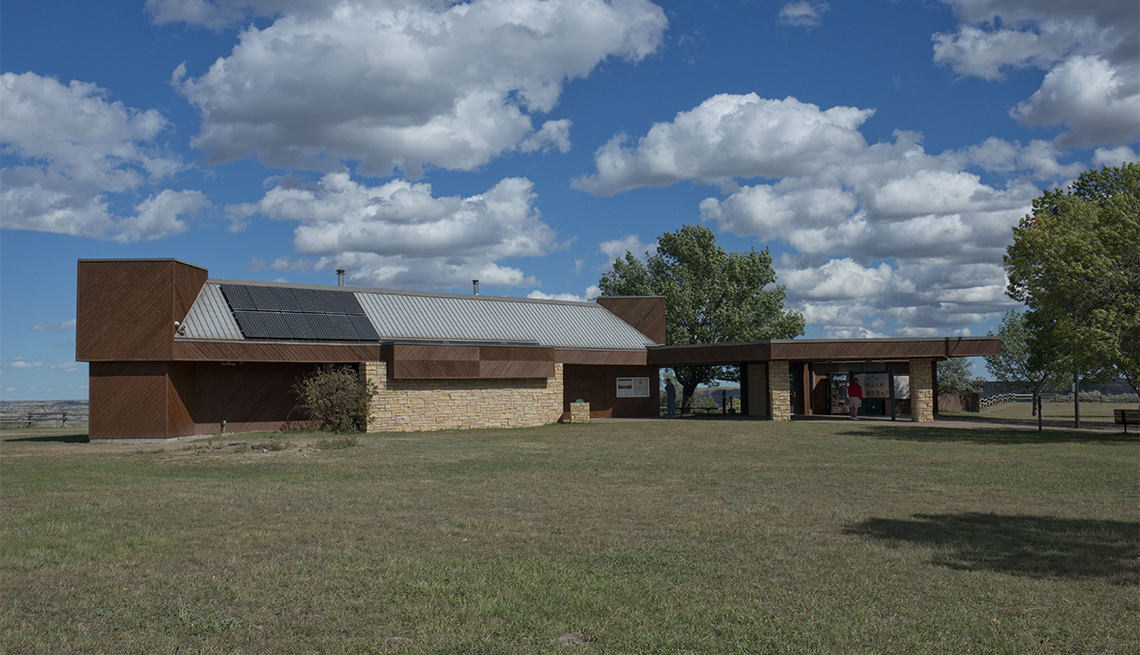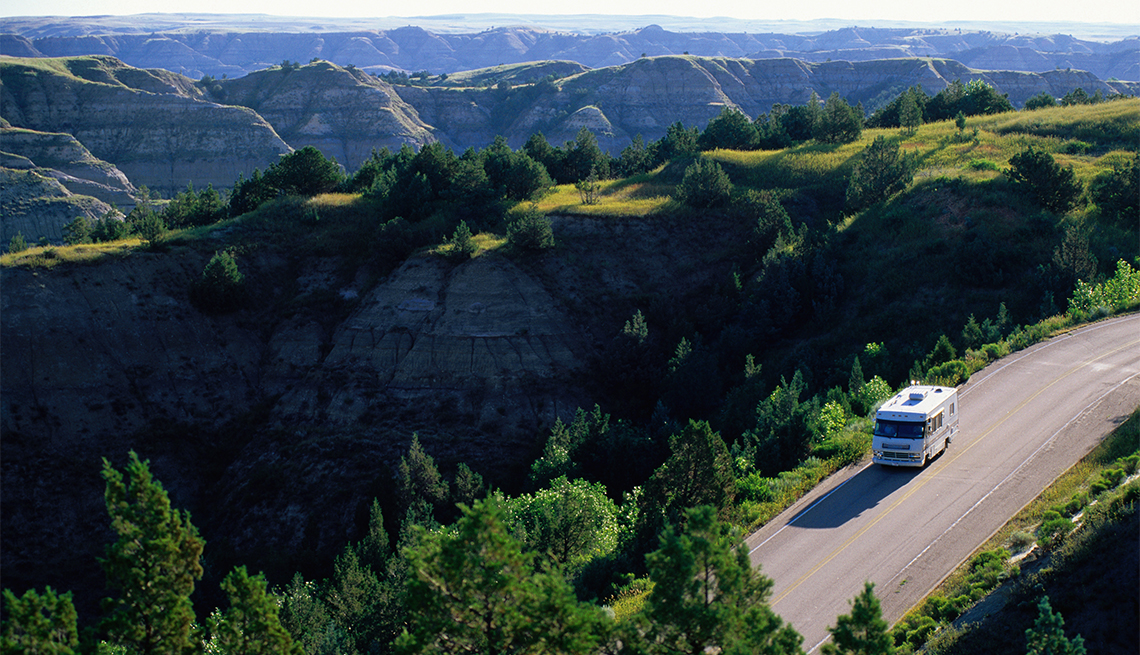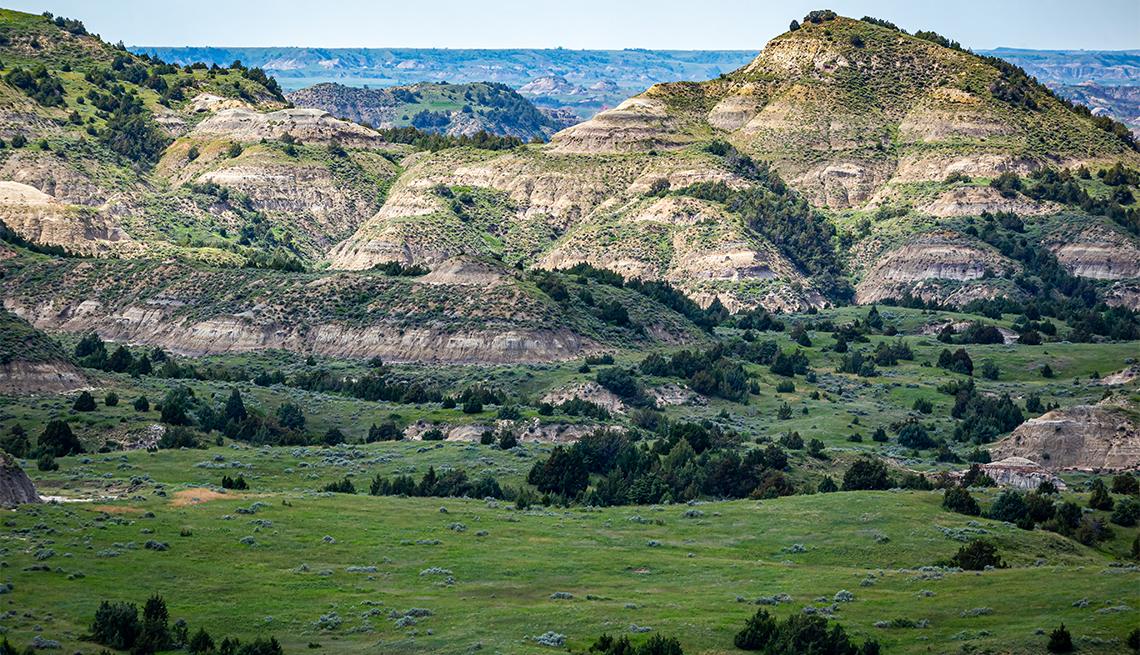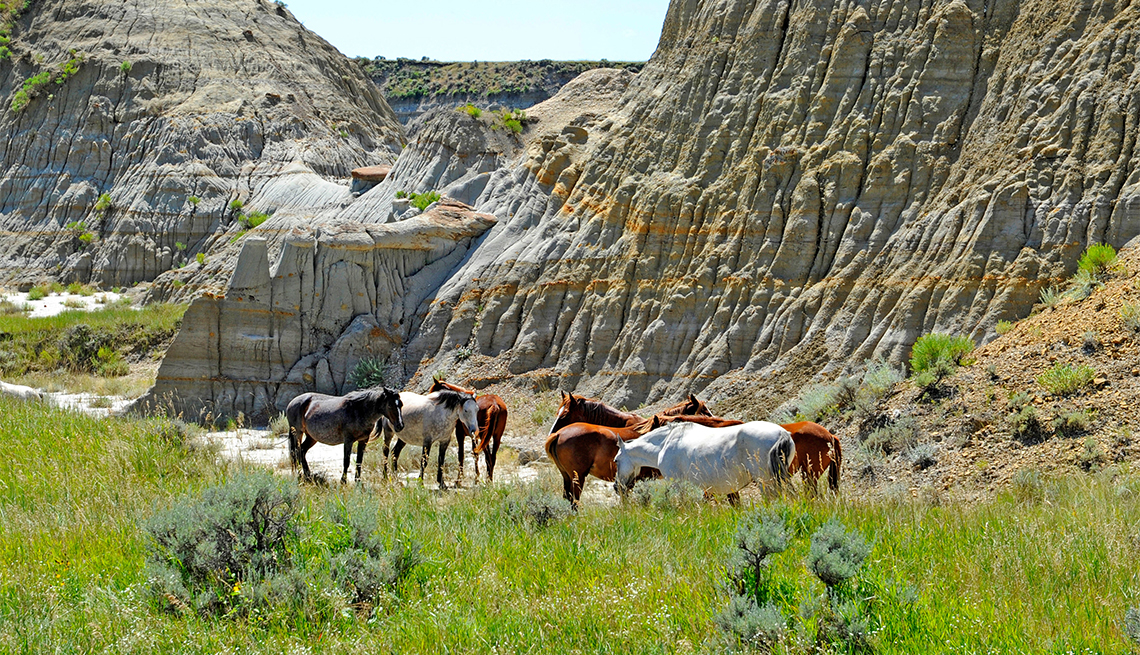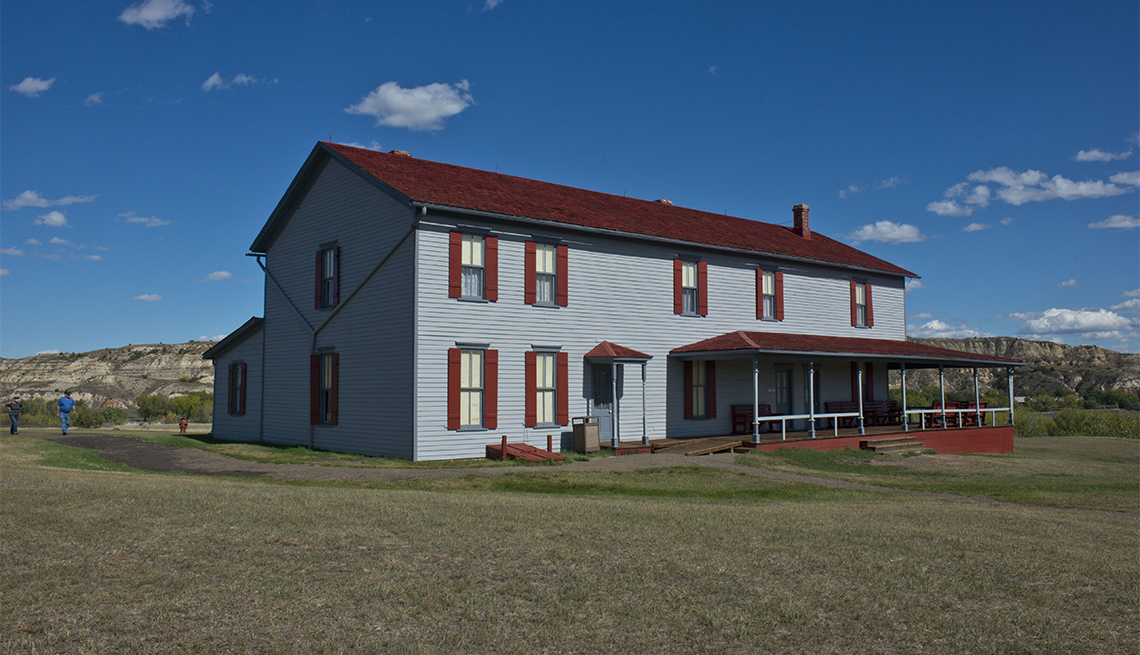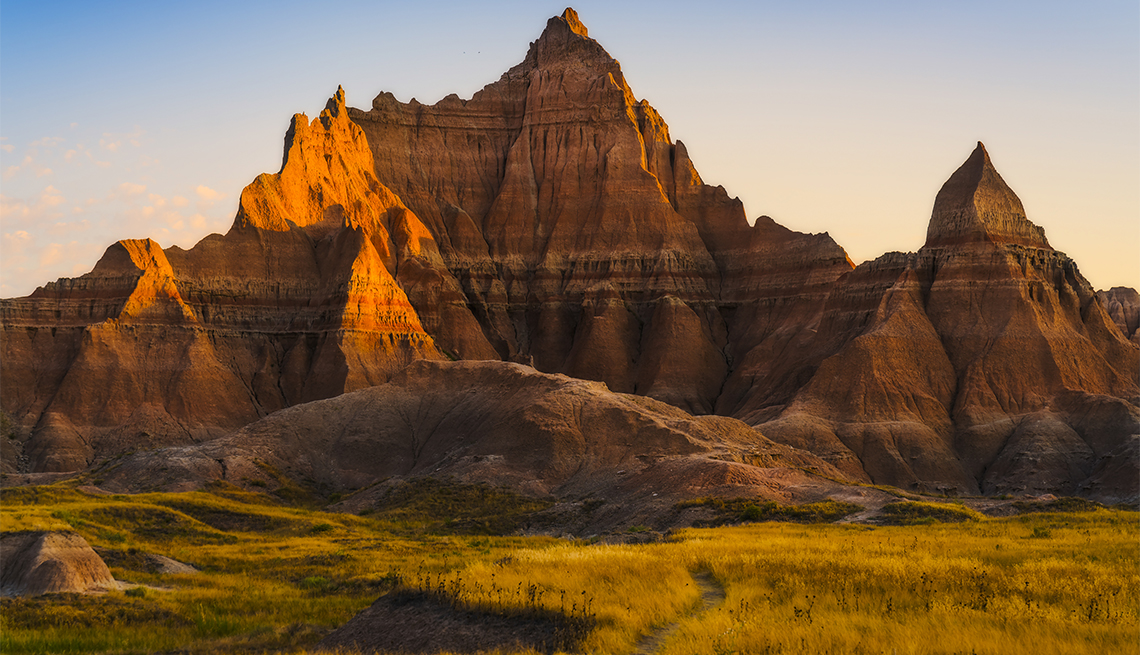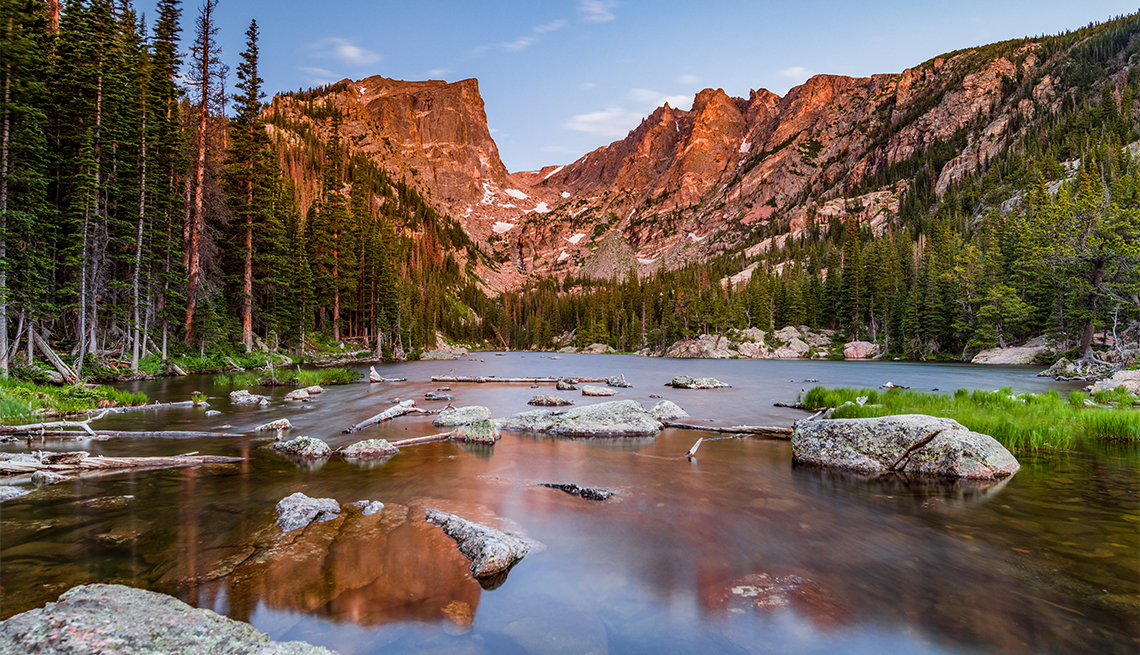AARP's Guide to Theodore Roosevelt National Park
Bison, prairie dogs, coyotes — a Dakota wildlife landscape
En español | Theodore Roosevelt National Park, in western North Dakota, is a fitting tribute to the “bully pulpit” president who helped birth America's conservation movement through sheer force of will: It protects an imposing landscape that is, simultaneously, both desolate and full of life. Bison roam the grassy plains and elk wander along juniper-filled draws. Prairie dogs squeak from mounds leading to their underground dens and mule deer bed down on the sides of clay buttes. There are antelope and coyotes, wild horses and bighorn sheep, and you can spot them all with a little patience. When the sun goes down, the layers of sedimentary rock come alive in the softer light: black veins of lignite, blue-gray layers of bentonite and rust-colored deposits of scoria. Stand atop a butte during the golden hour and the park takes on a whole new hue — and temperament. Perhaps no national park has such a split personality from afternoon to evening.
In 1884, Roosevelt himself retreated to this wide-open country after his wife, Alice Lee, and his mother, Mittie, died only hours apart. “The Bad Lands” he wrote of the area, “grade all the way from those that are almost rolling in character to those that are so fantastically broken in form and so bizarre in color as to seem hardly properly to belong to this earth.” In later years, he credited this landscape as having soothed him after his personal tragedies and set him back on course. “I have always said I would not have been President had it not been for my experience in North Dakota,” he once noted.
The North Dakota Badlands, not to be confused with South Dakota's Badlands National Park, have been cut over eons by the muddy Little Missouri River as it flows north, and the national park comprises three separate units totaling more than 70,447 acres. The South Unit lies along Interstate 94, adjacent to the tiny gateway town of Medora (just 112 full-time residents), and serves as the main recreational focus for most visitors, with its scenic driving loop and two dozen trails. The North Unit lies 70 miles away (an 80-minute drive), and while it has services such as a visitor center and a road through the badlands, it receives far fewer visitors. The Elkhorn Ranch Unit — the homesite of Teddy's Roosevelt 1880s cattle ranch — lies in between. It has no services, and most visitors make it a quick stop. Visiting them all is manageable over two or three days.
Summer is peak season for the park's 700,000 annual visitors, but even then you'll be all alone on hiking trails in the park's far corners, pondering with the same awe what Lewis and Clark must have experienced when they stumbled on these badlands during their 1805 journey across the continent. And you can truly get away in the North Unit. “Last year we were pushing that 700,000 visitors mark between the two units, and I would guess that 600,000 of the visits were registered in the South Unit. Visitors going to the North Unit are going for the seclusion,” says chief ranger Grant Geis.
With numerous activities outside park boundaries, easy drives inside it, and plenty of trails — ranging in length from 0.1 miles to 96 — TRNP appeals to those ages 50 and over, whether they've just completed an Ironman triathlon or are simply looking for a paved stroll. “The park is extremely friendly to the over-50 crowd. That's the bulk of our visitation,” Geis says.
Location: Medora, North Dakota
Total acres: 70,447
Miles of trails: 100-plus miles spread over 36 trails
Main attraction: The Badlands overlook at Painted Canyon.
Cost: $30 per vehicle for a seven-day permit
Best way to see it: On foot, walking one of its many trails through the Badlands or relaxing on an overlook as the sun sets
When to go: Fall (September and October), when the leaves of the giant cottonwoods turn golden
Plan Your Trip
The largest nearby airport is two hours east (137 miles) in Bismarck, the state capital. The Dickinson Theodore Roosevelt Airport is closer (37 miles east), but it's easier to get a flight into Bismarck and drive to Medora, the nearest town to TRNP.
Many visitors drive up from South Dakota's Black Hills, home to Mount Rushmore, 260 miles to the south (a little more than four hours by car). That may seem like a haul, but the route north, along U.S. Route 85, offers some of the best stretches of the unbounded openness of the Great Plains. You'll see views that extend so far off into the rolling distance that it often feels as if you can see the Earth's curvature.
TRNP's entrance fee is $30 per vehicle, with the pass valid for all three units of the park for seven consecutive days. (A $20 annual America the Beautiful Senior Pass for those 62 or older gives holders access to all national parks and many federally managed recreational lands.) Restroom and visitor facilities spread throughout the main drives make pit stops easy. The surrounding area's recent oil-shale boom spurred the expansion of cell networks, meaning good coverage for such a sparsely populated area (although you may experience the occasional dead zone, depending on your carrier). Only the main visitor centers (and nearby hotels) offer Wi-Fi, however.
"Shoulder seasons,” when visitor numbers drop and animals roam more freely, are the best times to visit. Summers are hot, with average temperatures in the high 80s and the occasional thunderstorm. Spring rain showers often transform the hillsides to a bright green interspersed with the red scoria rock underneath. In fall, leaves of the giant cottonwood trees along the Little Missouri River turn golden, and there may be no better time to camp in the park. Winter, when temperatures can plunge to single digits, is much slower in terms of visitation and many side roads are closed, but fresh snow on the badlands may be one of the most remarkable sights of all.
Where to Stay and Eat
There are no hotel options inside TRNP but it does have two campgrounds for tents and RVs, although no hookups. Both lie in towering cottonwood groves near the Little Missouri River, with views to the bluffs beyond. Cottonwood Campground in the South Unit has 72 sites; Juniper Campground in the North Unit, 48. Sites are spread out enough that you have some privacy, and each has a fire grill and a picnic table. The camps have potable water and flush toilets in summer, but no showers. There are no restaurants or stores in the park to buy food, water, firewood or other supplies, so bring everything you need. Despite the lack of amenities, there’s always the thrill of waking up in the morning with wild horses or a bison walking through the cottonwood trees.
You can reserve a campsite up to six months in advance at recreation.gov, although half the sites are first come, first served. Permits are $14 per night ($7 for seniors) in summer and $7 ($3.50 for seniors) from October through April.
For lodging, restaurants and stores near the park, Medora is your best option (see the Gateway Towns section).
Things to Do
Theodore Roosevelt National Park may be one of the West's most unheralded national parks, but those who have experienced its charms know it's all about the bewitching badland views. It's also one of the region's most accessible national parks for a quick tour: Both the South and North units have scenic driving loops on which you can take in the majority of sites from the comfort of your car, and many of the most remarkable features — the South Unit's prairie dog town near Skyline Vista, for example — have paved walking trails adjacent to parking areas, making them wheelchair accessible. “The park in itself is conducive to seniors just in the way it's laid out,” Geis says. “You can see a whole lot from your car without having to get out and do extensive hiking, like up to an edge of a glacier or something. The bison, horses and prairie dogs — you can see them all just as easily from your front seat as after a three-mile hike."
The South Unit's 36-mile loop begins and ends at the visitor center in Medora, and it's easy to complete in two hours (that includes time to snap photos of bison or prairie dogs). On the drive, don't miss the Skyline Vista, an ideal vantage point for viewing the sunset; Badlands Overlook, which in the morning light reveals all of the contours of sheer bluffs and ravines; and Cottonwood Campground, for a picnic under the tall trees. For another easily accessible point in the South Unit, including for those using wheelchairs, the Painted Canyon Visitor Center — accessed from outside the park on Exit 32 of I-94 — offers an iconic view of the Badlands. From the overlook, the park stretches off toward the north, with juniper draws, scoria-topped buttes and grazing buffalo dotting the landscape.
The 28-mile round-trip road in the North Unit impresses with similar stellar views, including two Little Missouri River overlooks, the Oxbow and Riverbend overlooks. Both will wow you, but Oxbow delivers the more impressive view of the river below and the Achenbach Hills, which stretch to the horizon across the muddy water. Elkhorn Ranch is undeveloped — meaning no visitor services — but the drive to it parallels the river valley and, once there, you can walk next to the stone foundations that once supported Roosevelt's cabin.
Exploring the park on foot is the best way to get up close with the terrain and wildlife, and you'll find more than 100 miles of trails. The hikes are mostly short (under a mile or two) and flat, as the highest buttes only rise a few hundred vertical feet. But be mindful of the summer heat: Average highs climb to the mid-80s and it often feels hotter and drier, so bring plenty of water. “The hiking can range from moderately difficult down to easy, depending on the time of year and where you're going. It can be more intense, especially during a hot summer day, but we're not talking huge elevation gains. Most people can do these hikes,” Geis says, adding that he sees a wide range of ages on the trails.
In the South Unit, two can't-miss short hikes are the Wind Canyon Trail, a 20-minute (0.4 miles) stroll through a wind-sculpted canyon with stunning river views; and the Coal Vein Trail, a 40-minute hike (0.8 miles) that is the perfect way to learn about badlands geology. For example, you'll see and better understand the layers of ancient history: gray bentonite clay from distant volcanoes, black coal from plants and animals that once lived in the humid swamps that covered the area, and brick-colored clinker that formed from burning coal lit by wildfires or lightning strikes. In the North Unit, a good hour-long option is the 1.5-mile portion of the Achenbach Trail to Sperati Point, which courses through prairie grassland to a lookout over the valley below.
Cycling, an increasingly popular park activity, offers a novel way to explore the main roads at a slower pace, although you'll be competing with cars on busy summer days. “People in their late 30s to upper 60s, that seems to be the biggest bulk of our cyclists,” Geis says. “They skew older than mountain bikers, and it's great exercise. Plus, when you're riding on a bike, you're typically more in touch with your surroundings, whether it's the warm summer days or the wildlife. You don't have the distractions and the physical barriers of the vehicle."
Average road cyclists can complete the South loop in three or four hours. Dakota Cyclery in Medora rents bikes.
Gateway Towns
The only town associated with the park is Medora, and it more or less revolves around its status as TRNP's gateway. It plays up its history as an old railroad junction and does its best Old West impression: wooden boardwalks, hitching posts in front of hotels, chuckwagon diners and plenty of cowboy boots and hats. It all can feel overdone at times, but discovering the town's charm only happens when you fully embrace the kitsch.
Medora's many lodging options are mostly middle-of-the-road motels and basic kitchenette cabins. The best place to book: the 76-room Rough Riders Hotel in the heart of town, named for the volunteer cavalry unit Teddy Roosevelt commanded in the 1890s (it's rumored the 26th president gave a speech from one its balconies). It's a mix of Old West charm — tin ceilings, for example — and modern conveniences, such as walk-in showers. Summer rates start at $199; spring and fall rates (before May 29 and after Sept. 13, respectively), at $119. There's also the AmericInn by Wyndham Medora, a good, if standard, option with a pool (from $189). Both have wheelchair-accessible rooms.
For dining, start your morning at Farmhouse Café, which does everything well, from pancakes to steak and eggs. Come lunchtime, it's salads and sandwiches. For dinner, the Boots Bar and Grill features tasty pub food, and Theodore's Dining Room serves a bison osso bucco well worth the $39 price tag. At the Pitchfork Steak Fondue restaurant, chefs load steaks onto, yes, pitchforks and plunge them into hot oil to cook. Enjoy your meat fest al fresco, with tables on a bluff overlooking town — and the setting sun ($30 per person.)
If you want snacks and drinks for your cooler before visiting the park, stop at the Medora Convenience Store. For a full-sized grocery store, your best bet is the Family Fare Supermarket in Dickinson, 37 miles east (the city also offers lodging and dining options).
Medora has three main attractions. The Medora Musical bills itself as the West's “rootin'-tootinest, boot-scootinest show.” For two hours nightly, there's singing and dancing and live horses on stage — all in an outdoor amphitheater with sunset views. The North Dakota Cowboy Hall of Fame, a museum devoted to Western cultures and Native Americans, gives you a glimpse into the area's ranching and rodeo history. (Saddle up yourself at the Medora Riding Stables on the edge of town for hour-long rides up buttes and into canyons; $40 per person). Just outside Medora, the 26-room Chateau de Mores State Historic Site is the former summer home of a wealthy cattle baron. Constructed in 1883, it's now a museum delivering an authentic look into what life in the badlands might have been like back then.
Being the park's gateway, Medora fills up with visitors during the peak months of June, July and August, so you'll need reservations for lodging and many of its activities.
En Route to Theodore Roosevelt National Park
Most visitors who fly in to visit the park come through Bismarck. Driving west from the city, take the worthwhile detour at Exit 72 on I-94 to see North Dakota's Enchanted Highway, seven oversize metal sculptures spread along a 32-mile stretch of two-lane highway. The first art installation, “Geese in Flight,” claims a Guinness World Record for largest scrap-metal sculpture (110 feet high and 154 feet wide).
If you're driving north from Rapid City, South Dakota — the gateway to the Black Hills and Mount Rushmore — keep your eyes peeled as you drive out of the town of Bowman for a cheeky “art installation” on the western side of Highway 85: a kitchen stove sitting alongside a ditch with its door open. A sign reads “Open Range.” It's more of a comment piece than real artwork, but it makes its point regardless.
Driving northeast from Billings, Montana, stop at Makoshika State Park outside the city of Glendive for a taste of the geologic badland formations to come at TRNP, plus view the fossil remains of dinosaurs such as Tyrannosaurus rex. A triceratops skull in the new visitor center is worthy of the natural history museums in Chicago and New York.
- |
- Photos
Editor's note: This article was originally published on July 17, 2020. It's been updated to reflect recent COVID-19 developments.

